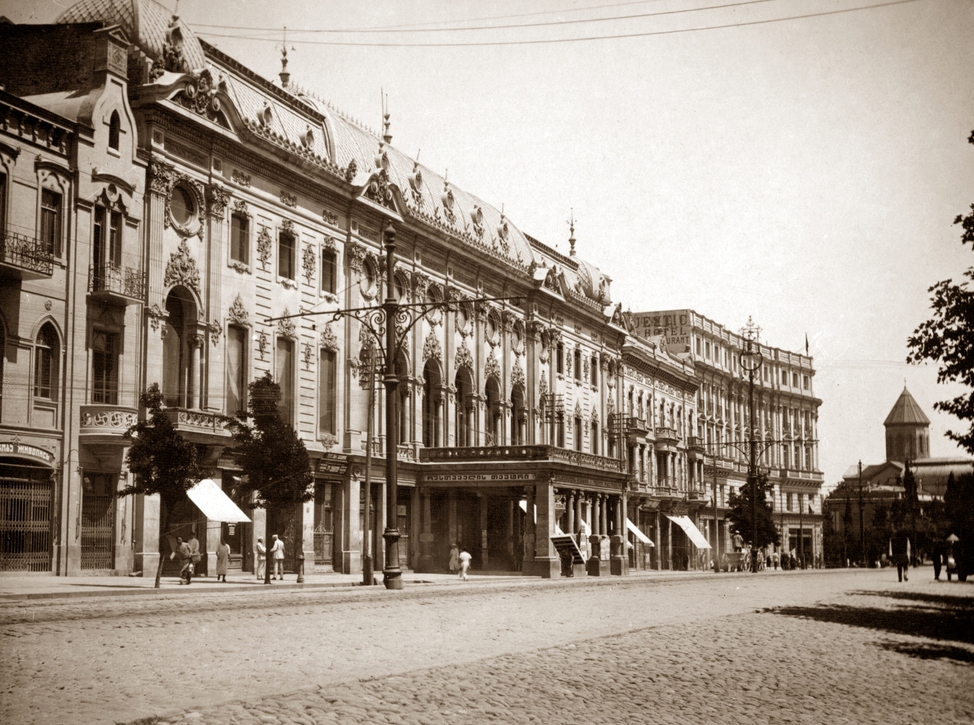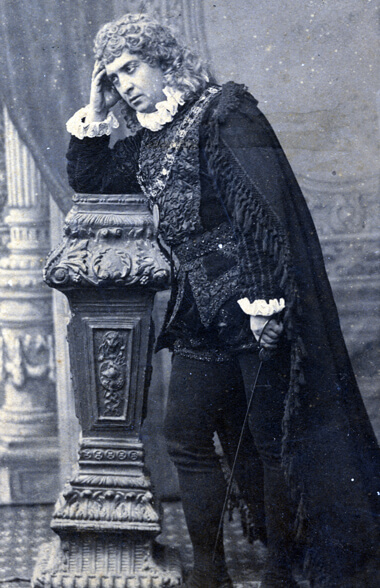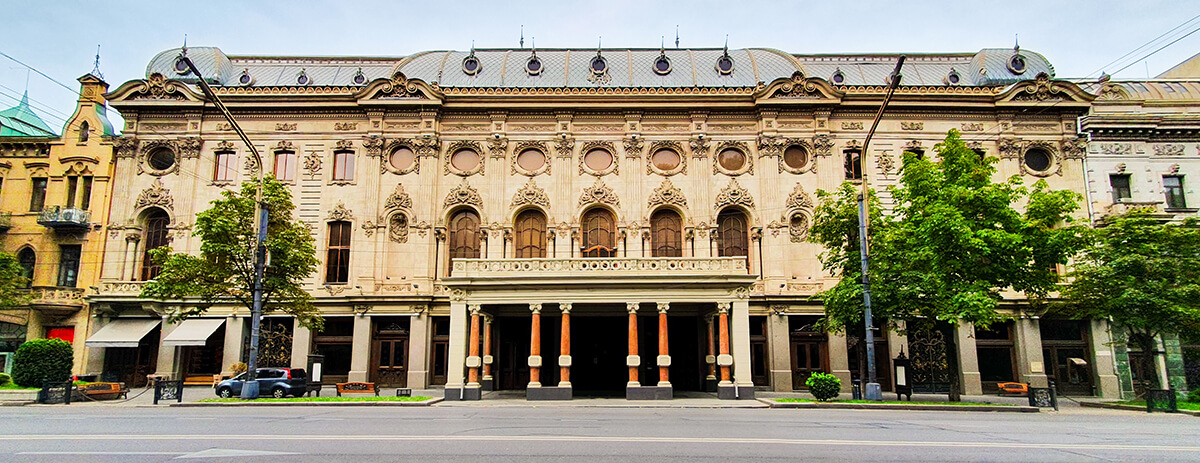The Georgian Drama Theater was named after Shota Rustaveli on November 25, 1921, but the history of the Rustaveli Theater began much earlier: "The theater is a great thing for our fallen people, we still don't have any signs of nationalism." It is one place where our language is heard publicly and acts publicly'' - wrote Ilia Chavchavadze.
In 1879, the members of the "Drama Committee", Ilia Chavchavadze, Akaki Tsereteli, Dimitri Kifiani, Davit Eristavi and Ivane Machabeli, adopted a charter, selected a building on the Palace Square, and on September 5, 1879, with their great efforts, the first season opened with Barbara Jorjadze's comedy "What I was looking and what did I find" (Director - G. Tumanishvili). For the restored Georgian theater, Ivane Machabeli translated Shakespeare's plays, and Davit Eristavi translated Sardu's "Flandria" - "Homeland" into Georgian (1882). The national aspiration of the theater was highlighted in this performance. Lado Meskhishvili, who played the role of Levan Khimshiashvili, was named a national hero. . .
In 1898, on Golovin Prospect (Rustaveli Avenue), the foundation was laid for the "House of the Artistic Society" (later Rustaveli Theater). On February 7, 1901, the newspaper "Iveria" reported: "On February 6, at 2 o'clock in the afternoon, the newly built building of Tbilisi's "Art Society" was consecrated on Golovin Prospekt. On March 5 of the same year, Aksenti Tsagareli's "Khanuma" was presented.
If at the end of the nineteenth century there was a constellation of actors on the Georgian stage: Vaso Abashidze, Mako Safarova-Abashidze, Nato Gabunia, Lado Meskhishvili, Valerian Gunia, Aleksandre Imedashvili, Elizabeth Cherkezishvili, Kote and Efemia Meskhebi, the twentieth century became the century of directors-leaders:
Kote Marjanishvili laid the foundation of "synthetic theater": direction, ensemble of actors, scenography, music, choreography serve to open the idea of the play. Marjanishvili's plays, Lope de Vega's "Sheep Spring" (1922), Z. Antonov's "Eclipse of the Sun in Georgia" (1923), Shakespeare's "Hamlet" (1925) and Konstantine Marjanishvili's "Mzetami" (1926) left an indelible mark in the history of Georgian theater.
Participation in the Moscow tours and the Union Olympics of 1930 and 1933 ("Break" (1928), "Anzor" (1928), "Lamara" (1930), "Tetnuld" (1931), ,, Bandits" (1933) brought international recognition to Alexander Akhmeteli and the theater. "Rustaveli Theater is a real national theater. Rustaveli Theater is national in its form, international theater in its artistic meaning," - K. Feldman.


Aleksandre Akhmeteli fell victim to the Soviet repressions of the 30s of the 20th century, together with his like-minded team: Ivane Abashidze, Platon Korisheli, Ivane Laghidze, Elguja Lortkifanidze, Ia Kantaria. Deported: Tamar Tsulukidze, Buzhuzha Shavishvili and Nina Ghviniashvili.
During the most difficult period for the country and the theater, Sh. Agsabadze staged Shakespeare's Othello (1937) in the Rustaveli Theater. "Khorava's Othello is not only a well-played role, but also a theatrical event. . .” - Vl. Nemirovich-Danchenko.
In the 50s of the 20th century, Dimitri Aleksidze remained loyal to the heroic-romantic trend that had become a tradition in the Rustaveli Theater. Among the works of this style, Sophocles' "Oedipus the King" and D. Gachechiladze's "Bakhtrioni" took over.
In the same period, director Mikheil Tumanishvili with a different handwriting and individuality worked in the Rustaveli Theater. He gathered a group of young actors, known to the Georgian theater community as the "Seven": Mikheil Tumanishvili, Medea Chakhava, Ramaz Chkhikvadze, Giorgi Gegechkor, Eros Manjgaladze, Guram Sagaradze and Badri Kobakhidze. It is Tumanishvili's name that is associated with the opening of a small stage with the play "Chinturaka" (1963). Tumanishvili's performances: i. Fuchiki's "People, be vigilant" (1951), J. Fletcher's "Spanish Priest" (1954), p. Kohout's "When there is such love" (1959), Zh. Anui's "Antigone" (1968) has written a new page in the history of Rustaveli Theater.
The generation of the sixties (Robert Sturua, Temur Chkheidze, Gogi Kavtaradze, Gizo Jordania...) established a new aesthetic in the theater. Robert Sturua's first successful play A. Miller's "Salem Process" (1965).
In the 1970s, the concept of "Robert Sturua's political theater" appeared: "Kvarkvare" (1974), "Caucasian Chalk Circle" Y (1975), "Richard III" (1979). The director staged about a hundred plays on the stage of the Rustaveli Theater, including: "Khanuma", "A Role for a Beginner Actress", "King Lear", "A Good Man from Szechuan", "Lamara", "Macbeth", "Then What" That it's wet, wet lilac", "Woman-snake", "Man-human?!", "As you wish, the twelfth night of Christmas", "Hamlet", "Styx", "Hunting season".
Robert Sturua's shows - "Caucasian Chalk Circle" and "Richard III" brought the theater world recognition. Rustaveli Theater had triumphant tours in many countries of the world, including England, Germany, France, Italy and Switzerland, Mexico, Australia, Finland and Iceland. He is a participant of Edinburgh, Avignon, Athens, Adelaide, Reykjavik, Jerusalem festivals.

Robert Sturua and his staged performances have been awarded with many national and international awards and prizes. Graduates of Gizo Jordania's acting class breathed new life into the small stage with performances: "The Diary of Anne Frank"(1987), "Samanishvili's Stepmother"(1987), "Tonight I Think There Will Be Wind"(1987), ,, Hamlet" (1991).
In the 80s and 90s, a new generation of directors: Avto Varsimashvili, Levan Tsuladze, Otar Egadze, Andro Enukidze, Gocha Kapanadze, Dato Sakvarelidze contributed to the creative life of the Rustaveli Theater.
Today, young directors and actors in the theater, together with the older generation, continue creative searches.



